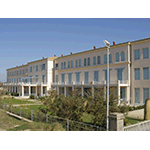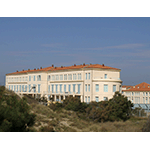Ex Colonia Marina Principi di Piemonte [Former Princes of Piemonte Seaside Camp]
The former "Prince Umberto and Princess Maria Josè of Piemonte" Seaside Camp was built in 1932 - 1933 to the project of the engineer Paolo Baldi Papini. Commissioned by the "Cassa di Risparmio di Pistoia e Pescia" bank on the occasion of its Centennial, it was rented, started in 1936, to the Pistoia Federation of Combat "Fasci", and then from 1941 on, to the Italian Lictorian Youth. The camp, which resumed its activity after the war, was again taken over by the "Cassa di Risparmio di Pistoia e Pescia" in 1960; in 1974 its activity ceased. Today, after long years of abandonment, the building complex has undergone major restoration and has been converted into a facility of the tourist/hotel type, within the context of the program for upgrading the Calambrone area.
The architectural complex, distinguished by geometric austerity, has retained its neo-classic character, the only example among the summer camps of rationalist style situated along the Tirreno Avenue. The planimetric form symbolically represents an airplane headed toward the sea, alluding figuratively to the original destination of the place as a summer camp for the children of Military Air Force personnel. The camp is formed of a main pavilion, extending parallel to the sea and distinguished by a portico supported by pilasters, which widens out into a semicircle at the centre, supported by seven columns. Another portico, enclosed by rectangular panes of glass, perpendicular to the main body, connects this construction to the pavilion behind it, symbolising the airplane's fuselage.
The summer camp was built within the context of the urban planning of the 1930s, which called for the foundation of a village for children whose original design was based on the Futurist idea of the manifesto One city with continuous lines, retaining a close relationship with the surrounding environment structured in bands (pinewoods, beach, and sea).
****************************
Texts by Graziano Magrini
English translation by Catherine Frost
Last update 07/feb/2008





